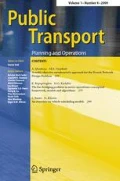Abstract
We propose rapid branching (RB) as a general branch-and-bound heuristic for solving large scale optimization problems in traffic and transport. The key idea is to combine a special branching rule and a greedy node selection strategy in order to produce solutions of controlled quality rapidly and efficiently. We report on three successful applications of the method for integrated vehicle and crew scheduling, railway track allocation, and railway vehicle rotation planning.




Similar content being viewed by others
Notes
The relative gap is defined between the best integer objective UB and the objective of the best lower bound LB as \(100\cdot\frac{\mathit{UB}-\mathit{LB}}{\mathit{UB}+10^{-10}}\).
References
Applegate D, Bixby R, Chvátal V, Cook W (1995) Finding cuts in the TSP (a preliminary report). Technical report, Center for Discrete Mathematics and Theoretical Computer Science (DIMACS). DIMACS Technical Report 95-05
Beale EML, Forrest JJH (1976) Global optimization using special ordered sets. Math Program 10:52–69
Beale E, Tomlin J (1970) Special facilities in a general mathematical programming system for non-convex problems using ordered sets of variables. In: Lawrence J (ed) Proceedings of the 5th international operations research conference. Tavistock Publications, London, pp 447–454
Borndörfer R, Schlechte T (2007) Models for railway track allocation. In: Liebchen C, Ahuja RK, Mesa JA (eds) ATMOS 2007—7th workshop on algorithmic approaches for transportation modeling, optimization, and systems, Dagstuhl seminar proceedings. internationales begegnungs- und forschungszentrum für informatik (IBFI), Schloss Dagstuhl, Germany. http://drops.dagstuhl.de/opus/volltexte/2007/1170
Borndörfer R, Grötschel M, Lukac S, Mitusch K, Schlechte T, Schultz S, Tanner A (2006) An auctioning approach to railway slot allocation. Compet Regul Netw Ind 1(2):163–196. ZIB Report 05-45 at http://opus.kobv.de/zib/volltexte/2005/878/
Borndörfer R, Löbel A, Weider S (2008) A bundle method for integrated multi-depot vehicle and duty scheduling in public transit. In: Hickman M, Mirchandani P, VoßS (eds) Computer-aided systems in public transport. Lecture notes in economics and mathematical systems, vol 600. Springer, Berlin, pp 3–24. ZIB Report 04-14 at http://opus.kobv.de/zib/volltexte/2004/790/
Borndörfer R, Grötschel M, Jäger U (2010a) Planning problems in public transit. In: Grötschel M, Lucas K, Mehrmann V (eds) Production factor mathematics. Springer, Berlin Heidelberg, pp 95–122, acatech. ZIB Report 09-13
Borndörfer R, Schlechte T, Weider S (2010b) Railway track allocation by rapid branching. In: Erlebach T, Lübbecke M (eds) Proceedings of the 10th workshop on algorithmic approaches for transportation modelling, optimization, and systems. OpenAccess series in informatics (OASIcs), Dagstuhl, Germany, vol 14, pp 13–23. Schloss Dagstuhl–Leibniz-Zentrum fuer Informatik
Borndörfer R, Reuther M, Schlechte T, Weider S (2011) A hypergraph model for railway vehicle rotation planning. In: Caprara A, Kontogiannis S (eds) 11th workshop on algorithmic approaches for transportation modelling, optimization, and systems. OpenAccess series in informatics (OASIcs), Dagstuhl, Germany, vol 20, pp 146–155. Schloss Dagstuhl–Leibniz-Zentrum fuer Informatik
Cambini R, Gallo G, Scutellà M (1997) Flows on hypergraphs. Math Program, Ser B 78(2):195–217
Caprara A, Toth P, Fischetti M (2000) Algorithms for the set covering problem. Ann Oper Res 98(1–4):353–371
Caprara A, Monaci M, Toth P, Guida PL (2006) A Lagrangian heuristic algorithm for a real-world train timetabling problem. Discrete Appl Math 154(5):738–753
Eckstein J, Nediak M (2007) Pivot, cut, and dive: a heuristic for 0-1 mixed integer programming. J Heuristics 13(5):471–503
Erol B, Klemenz M, Schlechte T, Schultz S, Tanner A (2008) TTPlib 2008—a library for train timetabling problems. In: Tomii A, Allan J, Arias E, Brebbia C, Goodman C, Rumsey A, Sciutto G (eds) Computers in railways XI. WIT Press, Southampton
Fischer F, Helmberg C (2010) Dynamic graph generation and dynamic rolling horizon techniques in large scale train timetabling. In: Erlebach T, Lübbecke M (eds) Proceedings of the 10th workshop on algorithmic approaches for transportation modelling, optimization, and systems. OpenAccess series in informatics (OASIcs), Dagstuhl, Germany, vol 14, pp 45–60. Schloss Dagstuhl–Leibniz-Zentrum fuer Informatik
Fischer F, Helmberg C, Janßen J, Krostitz B (2008) Towards solving very large scale train timetabling problems by Lagrangian relaxation. In: Fischetti M, Widmayer P (eds) ATMOS 2008—8th workshop on algorithmic approaches for transportation modeling, optimization, and systems, Dagstuhl, Germany. Schloss Dagstuhl-Leibniz-Zentrum für Informatik, Germany
Giacco GL, D’Ariano A, Pacciarelli D (2011) Rolling stock rostering optimization under maintenance constraints. In: Proceedings of the 2nd international conference on models and technology for intelligent transportation systems, Leuven, Belgium, pp 1–5. MT-ITS 2011
IVU Plattform (2008). Sequentielle oder Integrierte Optimierung? IVU Plattform. http://www.ivu.de/fileadmin/ivu/pdf/kundenzeitung/ger/2008/PlattformZtg-0802D-web1865.pdf
Kiwiel KC (1995) Approximation in proximal bundle methods and decomposition of convex programs. J Optim Theory Appl 84(3):529–548
König FG (2009) Sorting with objectives—graph theoretic concepts in industrial optimization. Doctoral thesis, Technische Universität Berlin
Löbel A (1997) Optimal vehicle scheduling in public transit. Shaker Verlag, Aachen. Ph.D. thesis, Technische Universität Berlin
Lübbecke M, Desrosiers J (2005) Selected topics in column generation. Oper Res 53(6):1007–1023
Lusby R, Larsen J, Ehrgott M, Ryan D (2011) Railway track allocation: models and methods. OR Spektrum 33(4):843–883
Maróti G (2006) Operations research models for railway rolling stock planning. PhD thesis, Eindhoven University of Technology, Eindhoven, The Netherlands
Schlechte T (2012) Railway track allocation: models and algorithms. Doctoral thesis, Technische Universität Berlin
Subramanian R, Sheff R, Quillinan J, Wiper D, Marsten R (1994) Coldstart: fleet assignment at delta air lines. Interfaces 24(1):104–120
Wedelin D (1995) An algorithm for a large scale 0-1 integer programming with application to airline crew scheduling. Ann Oper Res 57:283–301
Weider S (2007) Integration of vehicle and duty scheduling in public transport. PhD thesis, TU, Berlin. http://opus.kobv.de/tuberlin/volltexte/2007/1624/
Author information
Authors and Affiliations
Corresponding author
Rights and permissions
About this article
Cite this article
Borndörfer, R., Löbel, A., Reuther, M. et al. Rapid branching. Public Transp 5, 3–23 (2013). https://doi.org/10.1007/s12469-013-0066-8
Published:
Issue Date:
DOI: https://doi.org/10.1007/s12469-013-0066-8




